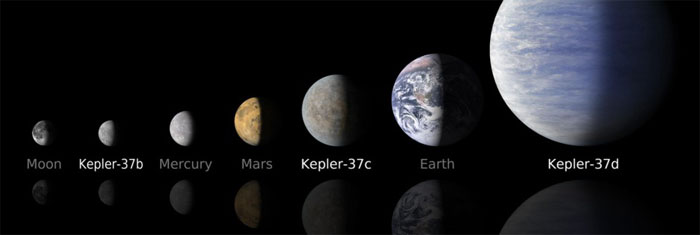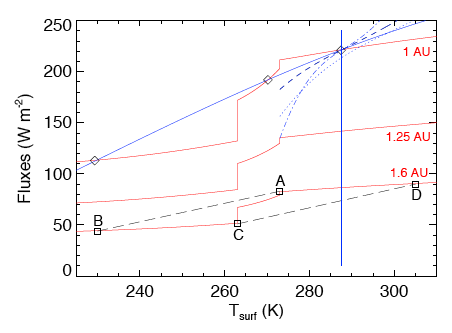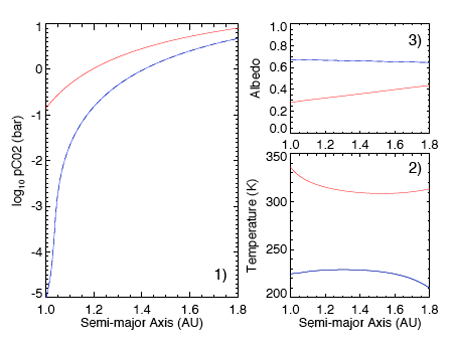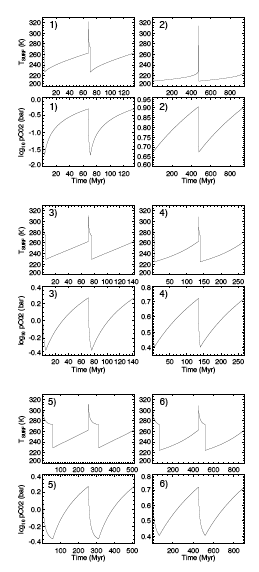.

Skizze:NASA
.
The carbon-silicate cycle regulates the atmospheric CO2 content of terrestrial planets on geological timescales through a balance between the rates of CO2 volcanic outgassing and planetary intake from rock weathering. It is thought to act as an efficient climatic thermostat on Earth and, by extension, on other habitable planets. If, however, the weathering rate increases with the atmospheric CO2 content, as expected on planets lacking land vascular plants, the carbon-silicate cycle feedback can become severely limited.
Here we show that Earth-like planets receiving less sunlight than current Earth may no longer possess a stable warm climate but instead repeatedly cycle between unstable glaciated and deglaciated climatic states. This has implications for the search for life on exoplanets in the habitable zone of nearby stars.
.
1. Introduction
It is generally thought that the carbon-silicate cycle acts as a stabilizing feedback and a powerful thermostat for the Earth climate, guaranteeing surface liquid water conditions. Above freezing temperatures, rock weathering occurs faster at higher temperatures, which reduces the CO2 atmospheric partial pressure, pCO2, and cools down the climate. Conversely, on a frozen planet that temporarily lacks weathering, atmospheric CO2 builds up from continued volcanic outgassing, which warms up the climate until surface liq-
uid water and weathering conditions are restored [1, 2, 3]. Such pCO2 build up is in fact the leading scenario for the deglaciation of Earth following a snowball event [4, 5, 6]. Generalizations of these concepts to Earth-like planets around other stars are central to the definition of their liquid water habitable zone [2, 7, 8]. In particular, planets subject to modest levels of insolation are expected to achieve temperate conditions with liquid water at the surface by building up massive enough CO2 atmospheres [2, 9, 10].



Experimental data, theoretical arguments and paleoclimate modeling suggest that the rate of CO2 intake via rock weathering by a planet lacking land vascular plants increases with the atmospheric CO2 content, pCO2 [3, 11, 12, 13, 14]. This feature of lifeless planets or planets with only primitive forms of life is important because it will limit the buildup of CO2 at high values. As a result, the climate thermostat due to the carbon-silicate cycle should become less efficient on weakly-insolated Earth-like planets located
in the outer regions of the habitable zone.
.
2. Climate-Weathering Models
To address this issue quantitatively, we model Earth-like climates with a zero-dimensional, energy balance model that equates the net insolation and thermal radiation fluxes,

where S is the insolation flux,
is the planetary Bond albedo and OLR is the outgoing longwave radiation flux emitted by the planet. OLR and are functions of the surface temperature, Tsurf , and pCO2, derived from radiative-convective climate models [9] (see Appendix A for details).
While we assume that the climate reaches thermal equilibrium rapidly, by virtue of Equation (1), the slower CO2 compositional equilibrium is not imposed a priori in our models. Rather, pCO2 is evolved on the relevant geological timescales according to

where V is the global CO2 volcanic outgassing rate (estimated as V =7 bars/Gyr for Earth [15]) and W is the rate of CO2 intake by the solid planet via rock weathering. The functional form of W is adapted from Earth studies for pre-vascular plant conditions [14]:

where p = 330 μbar is the pre-industrial pCO2 level, W = W ≡ V for Tsurf = 288K, kact = 0.09 is related to an activation energy and krun =0.045 is a runoff efficiency factor. Varying [14] kact in the range 0.06–0.135 and krun in the range 0.025–0.045 has only a minor quantitative impact on our results. Values of
= 0.25–1 have been considered in the literature [3, 12, 16, 17] for the dependence of weathering on pCO2 in the absence of land vascular plants. We use
= 0.5 (default) and 0.25 in this work. Note that equations (1) and (2) are coupled through pCO2 and Tsurf .
.
3. Climate Solutions
3.1. Steady-State Solutions Steady-state climate solutions, satisfying both radiative (Equation (1)) and weathering equilibrium (d/dt ≡ 0 in Equation (2)) are represented in
Figure 1 by intersecting cooling and heating curves. Solid red lines in Figure 1 show the albedo-corrected insolation flux (LHS of Equation (1)) received by a planet located at 1, 1.25 and 1.6 AU from a Sun-like star as a function of surface temperature.1 Net insolation drops precipitously from 273K to 263K as the planetary surface freezes and the albedo reaches ∼ 0.65.
The various blue lines in Figure 1 represent the OLR cooling flux (RHS of Equation (1)) according to various scenarios for the atmospheric CO2 content.
A standard model with pCO2 arbitrarily fixed at p = 330 μbar (i.e. not constrained by Equation (2)) is represented by the slanted solid blue line. As is well known [18, 19, 20], three steady-state climate solutions exist in such a model for an Earth-like planet at 1AU, as indicated by diamonds where the red and blue curves intersect. Earth’s current climate (Tsurf ≃ 288 K) and a globally-frozen state (Tsurf ≃ 229 K) are both stable, while the intermediate state (Tsurf ≃ 270 K) is thermally unstable.
However, when pCO2 is also required to satisfy weathering equilibrium (Equation (2)), steady-state climate+weathering solutions only exist above freezing temperatures since weathering stops operating on a frozen planet.
A model including weathering without any pCO2 dependence[9] (
= 0 in Equation (3)) is represented by the vertical solid blue line in Figure 1. In such a model, weathering equilibrium enforces a unique surface temperature, set by requiring that weathering balances volcanic outgassing in 1Even though the planetary albedo
in Equation (1) depends on pCO2, we find that this dependence is quantitatively negligible for pCO2 ≪ 0.2 bar. For simplicity, we plot heating (red) curves in this low pCO2 limit in Figure 1, which is indeed satisfied by all the cooling (blue) curves shown. All our other results fully account for the
–pCO2 dependence.
Equation (2), and pCO2 is only indirectly constrained by the constant Tsurf
requirement.
On the other hand, when the weathering rate depends on both pCO2 and Tsurf , noticeable bends appear in the blue cooling curves shown in Figure 1. Indeed, in this class of models, the reduced efficiency of weathering at low temperatures must be balanced by large pCO2 values to match the volcanic outgassing rate V . The weaker the weathering pCO2 dependence, the stronger is the pCO2 build-up at low surface temperatures (compare= 0.5 and 0.25 models represented by the dashed and dash-dotted lines in Figure 1, respectively). A planet with a larger volcanic CO2 outgassing rate [21] achieves a warmer stable climate (Tsurf ≃ 292 K for V = 3V and adopting our default weathering parameters, which is the case shown as adotted line in Figure 1).
Interestingly, stable climate+weathering solutions can cease to exist at low insolation levels, such as the 1.25 and 1.6 AU cases shown in Figure 1, for a strong enough dependence of the weathering rate on pCO2. For example, we find that blue curves no longer intersect with heating (insolation) lines beyond 1.077 AU if
= 0.5 and beyond 1.25 AU if
= 0.25. Conversely, a very weak weathering dependence on pCO2 (
< 0.1), including the singular case
= 0 (vertical solid blue line in Figure 1), do permit stable climate+weathering solutions at almost arbitrarily low insolation levels [9]. Low
values may be the relevant limit for planets where land vascular plants are widespread [3, 11, 12, 13, 14, 17]. On the other hand, for values of
∼ 0.25–0.5 appropriate for planets lacking land vascular plants [3, 11, 12, 13, 14, 17], the bending of cooling curves seen in Figure 1 also implies that at fixed volcanism rate, V , less insolated planets achieve climate+weathering equilibrium at gradually lower Tsurf values. For example, in the case
= 0.25 , equilibrium is only marginally achieved above freezing temperatures at 1.25 AU, as shown in Figure 1. At low enough insolation levels (far enough away from the star), climate+weathering equilibrium is no longer possible above freezing temperatures, which implies that weathering equilibrium is unattainable.
On planets lacking weathering equilibrium, the climate must repeatedly cycle through a succession of radiative equilibria as illustrated in Figure 1:rapid transition from marginal to full glaciation (A→B, at fixed pCO2), slow build-up of pCO2 caused by volcanic outgassing in the absence of weathering (B→C), rapid transition to a deglaciated state (C→D, at fixed pCO2) and gradual pCO2 decay under the action of weathering (D→A), until the cycle repeats again with full glaciation. The general properties of the four critical
points A-B-C-D of this climate cycle, which are independent of details of the weathering model, are quantified in Figure 2 as a function of orbital distance from a Sun-like star. Blue curves correspond to the coldest cycle point with the lowest pCO2 value, B, while the red curves correspond to the hottest point with the highest pCO2 value, D. Figure 2 shows that Earth-like planets at larger orbital distances glaciate and deglaciate at larger pCO2 values. A deglaciation with pCO2 ≃ 0.14 bar at 1 AU is consistent with values reported for snowball Earth deglaciation [6]. Planets beyond 1.3 AU support massive (> 0.3 bar) CO2 atmospheres throughout their climate cycle. Planets in the frozen state have albedos≃ 0.65, while the albedo of unfrozen planets rises from ≃ 0.3 to 0.45 in the range 1-1.8 AU, from an increasing atmospheric scattering contribution.
The extremes of surface temperature along the cycle vary modestly with insolation level, with Tsurf ≃ 210-225 K at the coldest point and 310-330 K at the hottest point.
3.2. Climate Cycles
Explicit time-dependent integrations of the system of Equations (1)-(3) reveal details of the climate cycle illustrated in Figure 1. We initiated these integrations at the hot, high pCO2 (weathering-independent) point D and confirmed that Earth-like planets receiving sufficiently large insolation fluxes settle to a steady-state warm climate solution after relaxation to weathering equilibrium. By contrast, planets at large enough orbital distances (low enough insolation levels) experience large amplitude climate cycles, as antic-
ipated from our discussion of equilibrium solutions in relation to Figure 1. Figure 3 shows six illustrative examples (A-F) of such climate cycles, shown in terms of variable Tsurf and pCO2 curves. Most of the cycle time is spent in the frozen state, during which pCO2 build-up is slow compared to the fast weathering that occurs at above-freezing temperatures. In model 1, 4.6% of the 70 Myr cycle is spent in a warm state with surface liquid water.
The corresponding numbers are 0.8% of 477 Myr in model 2, 7.5% of 76 Myrin model 3, 3.9% of 139 Myr in model 4, 28% of 312 Myr in model 5 and 17% of 517 Myr in model 6. Faster weathering at higher Tsurf also implies that most of the time in the unfrozen state is spent just above freezing temperatures, near the lowest pCO2 levels covered during the cycle. For a fixed volcanic outgassing rate, V , the climate cycle duration increases with decreasing insolation because larger absolute pCO2 values must be reached
for climate transitions to occur (Figure 2). Decreasing insolation also reduces the fraction of cycle time spent with surface liquid water by the planet, although this can be compensated for by stronger volcanic outgassing. A weaker pCO2 weathering dependence (lower
) lengthens the duration of the unfrozen state since the decline in pCO2 with time has less of an effect on the weathering rate.



To summarize, a temperature-only dependence of the weathering rate (
= 0) uniquely ties the surface temperature to the volcanic outgassing rate V via Equation (2). A more general dependence on pCO2 (
> 0) leads to a richer set of climate solutions, including unstable climate cycles at low enough insolation levels, when weathering equilibrium ceases to exist. These results are not specific to the weathering functional form adopted in Equation (3), in the sense that other weathering laws with a positive dependence on pCO2 and Tsurf would lead to qualitatively similar climate behaviors.
.
4. Conclusions
The key new feature of our analysis is the lack of stable climates on Earth-like planets lacking land vascular plants, at low enough insolation levels. This suggests that a subset of Earth-like planets located in the outer regions of habitable zones may be preferentially found in a frozen, rather than deglaciated, state. A globally frozen state might be observationally inferred from the very high albedo and the correspondingly low water content of the planet’s atmosphere. According to these results, some Earth-like planets in the outer habitable zone would also be caught in a transiently warm state with surface liquid water present only infrequently.
The link between unstable climate cycles and the emergence and evolution of life on weakly-insolated Earth-like planets is unclear but possibly important. A reduced amount of time with surface liquid water on planets experiencing climate cycles could in principle slow down the emergence and/or evolution of life. On the other hand, life itself could strongly impact the weathering process on weakly-insolated Earth-like planets, as it seems to have done on early Earth [3, 11, 12, 13, 14, 17]. In particular, the ability of land vascular plants to regulate the soil pCO2 level that is relevant to the weathering process, well above atmospheric pCO2 levels, is consistent with these plants effectively decoupling the weathering rate from the atmospheric pCO2 level [3, 11, 12, 13, 14, 17], leading to
→ 0 in Equation (3).
As a result (Figure 1, vertical line), the climate of weakly-insolated Earthlike planets could be stabilized against transient cycles once the presence of land vascular plants becomes widespread. This would constitute a strong example of life exerting a feedback on its environment.
It is worth noting that Earth’s geological record is qualitatively consistent with the evolutionary path one may envision for a habitable planet orbiting a star that is gradually brightening over time. Repeated snowball events should be restricted to early times, when insolation is weak and land vascular plants are absent. They should disappear at late times once insolation is strong enough and/or land vascular plants become widespread.
Acknowledgments
This work was supported by the Natural Sciences and Engineering Research Council of Canada. The author is grateful to J. Leconte and D.Valencia for comments on the manuscript.
Appendix A. Energy Balance Climate Model.
We model the climate of Earth-like planets with a zero-dimensional reduction of a one-dimensional energy balance model [9]. The model assumes Earth parameters unless otherwise specified (e.g., surface gravity, land/ocean fraction and nitrogen contribution to the total atmospheric mass).
Greenhouse effect from atmospheric H2O and CO2 are included, with an atmospheric vapor pressure set by surface evaporation (temperature).
The top-of-atmosphere albedo and the outgoing longwave radiation flux are modeled as polynomial fits to a large number of radiative-convective models [9]. The polynomial fits are functions of surface temperature, partial CO2 pressure, solar zenith angle and surface albedo. Simple prescriptions for snow/ice coverage, surface albedo and water cloud coverage are adopted [9].
For simplicity, we fix the cosine of the zenith angle to μ = 0.4 and the albedo of ice-free oceans to 0.07 in all the models presented here. We also smooth out the top-of-atmosphere albedo polynomials near the 280 K transition to improve the continuity of the albedo function with temperature. Based on published results [2], we expect that our results would be quantitatively different, but remain qualitatively valid, for planets that differ modestly from Earth in terms of their surface gravity, land/ocean fraction and/or nitrogen atmospheric content. Note that it has been suggested that weathering does not strongly depend on land/ocean fraction on an Earth-like planet [16].
The energy balance model employed here may not be fully reliable beyond 1.3-1.4 AU, where CO2 clouds are expected to form and influence the climate [9, 10]. The most massive CO2 atmospheres found in our models only marginally approach hard limits on CO2 condensation [22].

Figure 1: Climate at global radiative equilibrium for an Earth-like planet. Red lines show the albedo-corrected insolation (heating) flux as a function of surface temperature, Tsurf , at 1 AU (top), 1.25 AU (middle) and 1.6 AU (bottom) from a Sun-like star. Blue lines show the infrared cooling flux (OLR) according to various scenarios for the atmospheric CO2 content (slanted solid line: fixed pCO2 model; dashed:
= 0.5 weathering model; dotted:
= 0.5 weathering model with 3 times larger CO2 outgassing rate; dashed-dotted:= 0.25 weathering model; vertical solid:
= 0 weathering model). When no stable climate exists at large orbital distances (absent blue-red intersections), the climate must repeatedly cycle through points A-B-C-D shown in the 1.6 AU case, with a slow pCO2 build-up (B-C), a transition to a hot climate (C-D), a weathering period with decreasing pCO2 (D-A) and a transition to global glaciation (A-B).
.

Figure 2: Values of atmospheric partial CO2 pressure (1), surface temperature (2) and planetary albedo (3) at extremes of the climate cycle illustrated in Figure 1, as a function of orbital distance from a Sun-like star. Blue curves correspond to point B (cold, high albedo, low pCO2) and red curves to point D (hot, low albedo, high pCO2) of the cycle shown in Figure 1.
.

Figure 3: Six examples of time-evolved climate cycles, with two full cycles shown in each case. For each model (1-6), the evolution of atmospheric partial CO2 pressure (lower panel) and surface temperature (upper panel) are shown. Model 1: Default weathering model at 1.1 AU (
= 0.5 in Equation (3)). Model 2: Default weathering model at 1.8 AU. Model 3: 3 times larger CO2 outgassing rate at 1.3 AU. Model 4: 3 times larger CO2 outgassing rate at 1.6 AU. Model 5: Weaker pCO2 weathering dependence (
= 0.25) at 1.3 AU. Model 6: Weaker pCO2 weathering dependence (
= 0.25) at 1.6 AU. Increasing the CO2 outgassing rate shortens the duration of the cold, CO2 build-up phase. Weakening the weathering pCO2 dependence (
= 0.25 rather than 0.5) lengthens the duration of the hot weathering phase, resulting in a much larger fraction of time spent with surface liquid water.
.
Appendix B. Model Simplifications and Limitations.
Our models are idealized in a number of important ways. In addition to the simplified, zero-dimensional treatment of climate described above, which suggests the possibility of richer behaviors in higher complexity, threedimensional climate models, our treatment of weathering processes is intentionally simple, in order to isolate they key factors that determine climate stability. We ignore seafloor weathering [16] and the mantle CO2 cycle [23].
The absolute calibration of weathering rates in the absence of land vascular plants is unknown, but it is thought to be less than in their presence [11]. For concreteness, we have chosen to calibrate weathering fluxes in our models using current Earth [13, 14] (Equation (3)). We note that in a model admitting steady-state solutions, a factor three decrease in the weathering rate is equivalent to a factor three increase in the volcanic outgassing rate (see Equation (2)), which is one of the cases shown in Figure 1 (dotted blue line). Such a model retains the main qualitative feature highlighted in this work, which is the disappearance of stable climates solutions at low enough insolation levels (beyond 1.2AU for the dotted blue line shown in Figure 1).
Different calibrations in weathering rates and/or volcanic outgassing rates will thus affect our results quantitatively, but our main conclusions should remain valid.
More generally, a planet is likely to change its weathering regime gradually over time, as different forms of life emerge and spread over its surface [3, 12]. Our models have intentionally focused on the distinction between the absence and presence of land vascular planets, which exemplifies the interplay between life, weathering processes and climate stability.
.
References
[1] Walker, J. C. G., Hays, P. B. and Kasting, J. F., A negative feedback
mechanism for the long-term stabilization of Earth’s surface tempera-
ture, J. Geophys. Res. 86, 9776-9782 (1981)
[2] Kasting, J. F., Whitmire, D. P. and Reynolds, R. T., Habitable Zones
around Main Sequence Stars, Icarus 101, 108-128 (1993)
[3] Kump, L. R. , Brantley, S. L. and Arthur, M. A., Chemical Weathering,
Atmospheric CO2 and Climate, Annu. Rev. Earth Planet. Sci. 28, 611-
667 (2000)
[4] Kirschvink, J. L. , in The Proterozoic Biosphere: A Multidisciplinary
Study, eds. Schopf J. W. , Klein C. (Cambridge University Press, Cam-
bridge, UK), pp. 51-52 (1981)
[5] Hoffman, P. F. , Kauffman, A. J., Halverson, G. P. and Schragg, D. P.,
A Neoproterozoic snowball earth, Science 281, 1342-1346 (1998)
[6] Hoffman, P. F. and Schragg, D. P., The snowball Earth hypothesis,
Terra Nova 14, 129-155 (2002)
[7] Forget, F. and Pierrehumbert, R. T., Warming Early Mars with Carbon
Dioxide Clouds That Scatter Infrared Radiation, Science 278, 1273-
1276 (1997)
[8] Kopparapu, R. K., et al., Habitable Zones around Main-sequence Stars:
New Estimates, Astrop. J. 765, 131-147 (2013)
[9] Williams, D. M., and Kasting, J. F., Habitable Planets with High Obliq-
uities, Icarus 129, 254-267 (1997)
[10] Selsis, F., Kasting, J. F., Levrard, B., Paillet, J., Ribas, I. and X.
Delfosse, X. , Habitable planets around the star Gliese 581?, Astron.
Astrop. 476, 1373-1387 (2007)
[11] Schwartzman, D. W. and Volk, T., Biotic enhancement of weathering
and the habitability of Earth, Nature 340, 457-460 (1989)
[12] Berner, R. A., Geochimica et Cosmochimica Acta 56, 3225-3231 (1992)
[13] Berner, R. A., Geocarb II: A revised Model of Atmospheric CO2 over
Phanerozic Time, Amer. J. Science 294, 56-91 (1994)
[14] Berner, R. A. and Kothavala, Z., Geocarb III: A revised Model of At-
mospheric CO2 over Phanerozic Time, Amer. J. Science 301, 182-204
(2001)
[15] Abe, Y., Abe-Ouchi, A., Sleep, N. H. and Zahnle, K. J., Habitable Zone
Limits for Dry Planets, Astrobiology 11, 443-460 (2011)
[16] Abbot, D. S., Cowan, N. B. and Ciesla, F. J., Indication of Insensitivity
of Planetary Weathering Behavior and Habitable Zone to Surface Land
Fraction, Astrop. J. 756, 178-191 (2012)
[17] Pierrehumbert, R. T., Principles of Planetary Climate (Cambridge:
Cambridge Univ. Press, 2010)
[18] Budyko, M. I., The effect of solar radiation variations on the climate of
the Earth, Tellus 21, 611-619 (1969)
[19] Sellers, W. D., A global climatic model based on the energy balance of
the Earth-atmosphere system, J. Appl. Meteorol. 8, 392-400 (1969)
[20] North, G. R., Cahalan, R. F. and Coakley Jr., J. A., Energy balance
climate models, Rev. Geophys. Space Phys. 19, 91-121 (1981)
[21] Kite, E. S., Manga, M. and Gaidos, E., Geodynamics and Rate of
Volcanism on Massive Earth-like Planets, Astrop. J. 700, 1732-1749
(2009)
[22] von Paris, P., Grenfell, J. L., Hedelt, P., Rauer, H., Selsis, F. and
Stracke, B., Atmospheric constraints for the CO2 partial pressure on
terrestrial planets near the outer edge of the habitable zone, Astron.
Astrop. 549, 94-102 (2013)
[23] Sleep, N. H. and Zahnle, K., Carbon dioxide cycling and implications
for climate on ancient Earth, JGR 106, 1373-1400 (2001)
.
Quelle: Centre for Planetary Sciences, Department of Physical & Environmental Sciences, University of Toronto at Scarborough, Toronto, Ontario M1C 1A4, Canada
Department of Astronomy & Astrophysics, University of Toronto, Toronto, Ontario M5S 3H4, Canada
4025 Views

